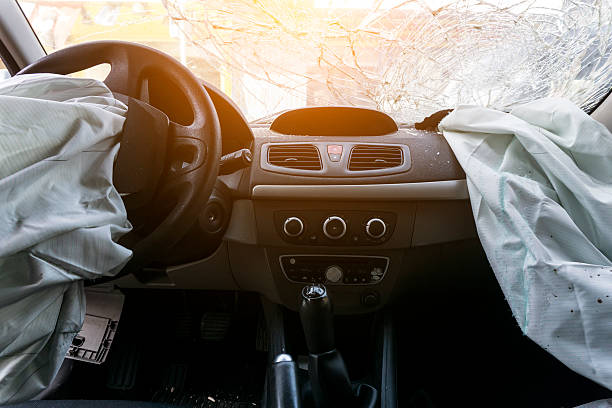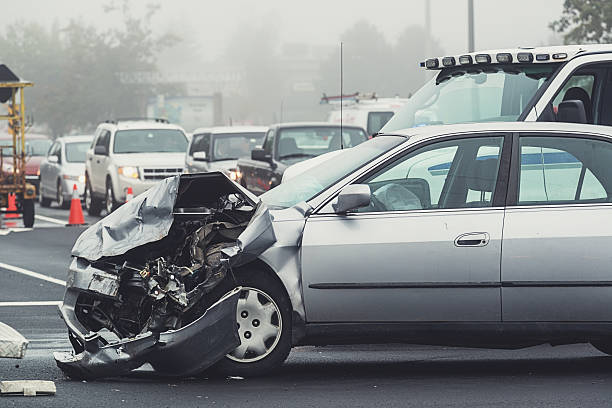Everything that moves has mass (weight) and velocity (how fast it’s moving in a certain direction). When something has mass and velocity, it has kinetic energy. The heavier and faster your car, the more kinetic energy it has.
But when you suddenly stop or crash, all that energy has to go somewhere. It’s a basic law of physics called Newton’s first law of motion.
Cars have seatbelts to help, but they only restrain your body. Your head, which weighs a lot, isn’t restrained at all. So, even if your body is held tight, your head can keep moving and hit the steering wheel or windshield. That’s why we have airbags—they help protect your head.

If you’re unfortunate enough to be involved in a car accident, your airbag will hopefully come out from the dashboard to cushion the impact. Also known as a supplementary restraint system (SRS), an airbag is designed to help the seatbelts protect you rather than replace them. The airbag inflates when the car begins to decelerate during a collision and then deflates as your head pushes against it.
How Airbags Work
Here’s a step by step guide to help you understand how airbags work:
- When a car crashes into something, it suddenly slows down significantly and a special chip called an accelerometer feels this sudden change in speed.
- Then if the deceleration is significant enough, the accelerometer signals the airbag to get activated. It then sends electricity through a wire that gets really hot. This hot wire sets off an explosive chemical and when it burns, it makes a lot of gas (usually nitrogen or argon).
- The gas fills up a bag made of nylon that’s hidden behind the steering wheel. As the bag expands it pops out in front of the driver, pushing off a plastic cover.
- The bag is covered with a powdery stuff like talcum powder to help it open smoothly. If you’re driving the vehicle, you will move forward due to the collision and your head/face will press into the bag, which in turn causes the bag to deflate. By the time your car stops, the bag should be completely flat again.

How Effective are Airbags?
Airbags might seem like a great idea, but do they actually save lives? In a study from 1995, researchers AK Lund and SA Ferguson looked at road accidents from 1985 to 1993. They discovered that airbags reduced deaths by as much as 24% in head-on crashes and by 16% in all kinds of crashes, compared to cars with only manual seatbelts.
That’s a big improvement, but airbags themselves can be dangerous. They’re like small explosions, and they can cause harm. The biggest risk is to young kids, but adults can also get hurt, with a small chance of eye or ear damage.
Still, if an airbag saves your life, you probably think a little risk is worth it. But it’s essential to understand the airbag’s dangers so we can make them safer.
Newer airbags, used since the late 1990s, are less forceful, and there’s good evidence that they’ve lowered accidental deaths, especially among kids, while still keeping passengers safe.
Are There Times When Airbags Should Not Deploy?
Airbags have specific conditions under which they deploy. They might not go off if the speed, angle of impact, and other important factors don’t meet certain requirements. So, if an airbag doesn’t activate, it doesn’t necessarily mean it’s broken.
Here are some instances when airbags may not deploy:
- Minor crashes where an airbag isn’t needed to keep people safe, like a gentle bump.
- When a small person or a child is sitting in the front seat, or if the seat is empty (Many cars have sensors to detect these situations.)
- If the crash doesn’t affect the part of the car where the airbag sensor is located.
Sometimes, deploying an airbag can cause worse injuries than not having one at all—although most are designed to avoid this. But, occasionally, there could be a problem with the airbag itself, or something wrong with the car that stops it from going off.
Can I Sue If My Airbags didn’t Deploy?
You can definitely sue if your airbags did not deploy (as they’re supposed to) when you got into a car accident. However, it’s not always clear and simple who you should sue. There might be multiple parties involved and depending on the circumstances of your accident, you may be able to sue the vehicle’s or airbag’s maker and other responsible parties.
Who is Liable for the Airbag’s Failure?
First of all, you need to determine who caused your car crash and who you want to take legal action against. If there’s a careless driver involved, you can seek compensation from them.
Now if you got hurt because your airbag didn’t work as expected, you can file a claim against the company that made your car or even the manufacturer of the airbag. You’ll need to show evidence or prove that:
- The airbags didn’t work during the crash.
- There was something wrong with how the airbags were made or designed.
- The injuries from the airbag problem caused you harm.
- You and others in the car got more hurt because of the airbag problem.
The Average Settlement for Airbags Not Deploying
There’s no such thing as an average settlement for airbags not deploying. The exact amount you may be eligible to recover will depend on a lot of factors such as the details of your accident, including:
- The severity of the accident
- The severity of your injuries
- The cost of your treatment
- Losses (lost income, etc.)
- How much the airbag contributed to your injuries
- Cause of the crash
- And other factors
In some cases, the car accident victim may have succumbed to their injuries. If your loved one died as a result of a crash involving a defective airbag, you can pursue damages based on the state’s laws pertaining to wrongful deaths. You can also hold the car maker and/or airbag manufacturer liable.
If your car’s airbags failed, they may be classified as an unreasonably dangerous product which means you may have a product liability claim against those involved in developing and producing them. The parties that are liable will vary based on the type of defect that caused the malfunction.

So, in a nutshell – if your vehicle got hit and you sustained injuries, you have a car accident claim. If the airbags did not deploy as they were supposed to, it means you also have a product liability claim.
You may be able to recover damages through a settlement or award (judge/jury) for the following:
- Medical expenses
- Repair expenses
- Lost income
- Pain and suffering
- Emotional trauma
- Disability
- At-home medical care
- Medical assistive devices
- Vehicle / home modification to accommodate a permanent or long-term disability
The final settlement you will receive hinges on how severe and extensive your injuries are from the accident. If the car crash caused catastrophic injuries, you can expect a higher settlement compared to one resulting in only minor and temporary injuries.